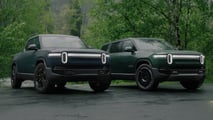
When the Rivian R1T and R1S launched in 2021 and 2022, they broke new ground in their own ways. The R1T was North America’s first modern electric truck, while the R1S offered a genuine three-row electric SUV experience, unlike the compromised three-rows of the Tesla Model Y and Model X.
Both Rivians received rave reviews, from InsideEVs included. However, customers faced teething issues related to software and maintenance. Now the EVs are in their second generation, and Rivian aims to consign these issues to the history books with improved electrical and wiring systems. Those changes should bring down Rivian's manufacturing costs as well.
Get Fully Charged
Servicing Rivian EVs isn't easy.
California EV start-up Rivian doesn't have the decades of experience that legacy carmakers have when it comes to after-sales service. R1S and R1T customers have had several serviceability issues, but Rivian has now taken several steps to address that, including incorporating advanced zonal electrical systems.
The new models boast an entirely new electrical architecture and computing platform that apparently make the “vehicles more robust, less costly to produce and easier to service—all while improving the experience for customers,” according to Rivian.
At the core of the system is a new zonal electrical architecture. It now uses just seven ECUs compared to 17 before. Each of the seven ECUs is now more powerful and has more computational capabilities. Rivian says this has helped it remove some 1.6 miles of wiring from each vehicle and reduce 44 pounds of weight.
If you’re new to how these things work, wiring harnesses are the car's nervous system. They send power and signals to different components and systems: lights, switches, speakers, cameras, you name it.
Gallery: 2025 Rivian R1T and R1S







Zonal architecture refers to EVs having different zones for wiring harnesses and modules. Instead of having a centralized wiring system with long cables connecting all components, zonal architecture organizes the wiring into smaller, more manageable sections.
Traditionally, cars have had miles of wiring harnesses that add weight and complexity. Tesla was the early mover when it came to simplifying these. The early Model S was said to have 2 miles of wiring harnesses. That was cut to one mile on Model 3 and just 100 meters on the Model Y.
Even Ford CEO Jim Farley has complained about this challenge with his company's EVs; he has previously railed at the heavy, costly and unnecessary amount of wiring on the Mustang Mach-E, something engineers are seeking to reduce on future Ford platforms.

Previously, some owners have complained about glitches on the infotainment screen and malfunctioning driver assistance features. Others said the R1S shifted drive on its own after coming to a halt at stop signs.
One R1T owner even told InsideEVs that his truck was out for repairs for eight months to replace a single side-view camera. To swap that out, the body shop had to take the interior apart, yank out the seats, and dismantle the dashboard. And then replace the entire wiring harness.
The owner’s R1S was the “guinea pig” in the whole service process, he told me early this year. Now Rivian seems to have taken serious steps to solve these issues in the second generation models.







